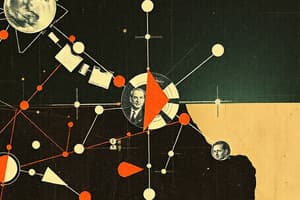Podcast
Questions and Answers
What term is used to refer to the dominant form of an isotope?
What term is used to refer to the dominant form of an isotope?
- Major isotope
- Primary isotope (correct)
- Only isotope
- Single isotope
How do isotopes with different mass numbers typically differ?
How do isotopes with different mass numbers typically differ?
- In solubility only
- In boiling points only
- In atomic numbers only
- In physical and chemical traits (correct)
How have isotopes been utilized as powerful tools in exploring atomic structure?
How have isotopes been utilized as powerful tools in exploring atomic structure?
- By being susceptible to specific types of radiation (correct)
- By serving as magnetic compasses
- By causing earthquakes
- By influencing weather patterns
What does the relationship among atomic number, mass number, and isotopic abundance allow chemists to do?
What does the relationship among atomic number, mass number, and isotopic abundance allow chemists to do?
How have chemists been able to develop more precise analytical instruments according to the text?
How have chemists been able to develop more precise analytical instruments according to the text?
Flashcards are hidden until you start studying
Study Notes
Unpacking Atomic Structure: Focus on Atomic Number, Mass Number, and Isotopes
Delving deep into the heart of matter, we find the complex yet fundamental fabric of every substance known as the atom. Composed primarily of three fundamental components — protons, neutrons, and electrons — each atom's composition and behavior dictate its place within the Periodic Table and influence its interactions with other atoms. Here, we examine some essential aspects of atomic structure related to the subtopics of atomic number, mass number, and isotopes.
Atomic Number
Atomic number, symbolized (Z), indicates the number of protons contained in an atom's nucleus. This crucial feature defines the identity of any element; thus, helium ((Z = 2)) is distinct from calcium ((Z = 20)). Consequently, elements are ordered sequentially along the Periodic Table according to increasing atomic number.
Mass Number
Mass number, symbolized (A), reflects the sum of both protons and neutrons in an atom's nucleus. Therefore, the mass number provides a measure of the overall nuclear weight of an isotope. This concept underpins our ability to distinguish between various forms of the same element, like ({}{6})C({}^{12}) and ({}{6})C({}^{13}) — two isotopes of carbon.
Isotopes
Isotopes share the same atomic number due to having the same number of protons. Nevertheless, isotopes differ in their mass numbers due to varying numbers of neutrons in their respective nuclei. While natural elements typically exhibit several isotopes, some occurrences involve only one dominant form, referred to as the primary isotope, like the case of ({}_{1})H({}^1) hydrogen.
Despite possessing identical atomic numbers, isotopes manifest diverse physical and chemical traits. Their mass differences lead to variations in boiling points, melting temperatures, solubility, half-life, and reactivity. Some even serve as powerful tools in exploring atomic structure further due to their susceptibility to specific types of radiation.
Applications and Evolution of Knowledge
This understanding of atomic structure allows us to predict trends in the periodic table, comprehend chemical bonding, and explore frontiers in fields ranging from medicine to astrophysics. To illustrate, the distinction between isotopes enables accurate dating techniques across geological time scales through methods like radiometric dating, providing insights into Earth's evolution. Moreover, the relationship among atomic number, mass number, and isotopic abundance has allowed chemists to develop increasingly precise analytical instruments and identify novel elements with confidence.
Studying That Suits You
Use AI to generate personalized quizzes and flashcards to suit your learning preferences.




